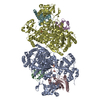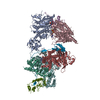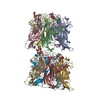+ Open data
Open data
- Basic information
Basic information
| Entry | Database: PDB / ID: 6rmh | |||||||||
|---|---|---|---|---|---|---|---|---|---|---|
| Title | The Rigid-body refined model of the normal Huntingtin. | |||||||||
 Components Components | Huntingtin | |||||||||
 Keywords Keywords | PROTEIN BINDING / multivalent scaffold platform | |||||||||
| Function / homology |  Function and homology information Function and homology information: / positive regulation of CAMKK-AMPK signaling cascade / microtubule-based transport / vocal learning / positive regulation of mitophagy / regulation of CAMKK-AMPK signaling cascade / profilin binding / positive regulation of cilium assembly / retrograde vesicle-mediated transport, Golgi to endoplasmic reticulum / vesicle transport along microtubule ...: / positive regulation of CAMKK-AMPK signaling cascade / microtubule-based transport / vocal learning / positive regulation of mitophagy / regulation of CAMKK-AMPK signaling cascade / profilin binding / positive regulation of cilium assembly / retrograde vesicle-mediated transport, Golgi to endoplasmic reticulum / vesicle transport along microtubule / positive regulation of aggrephagy / positive regulation of lipophagy / Golgi organization / dynein intermediate chain binding / establishment of mitotic spindle orientation / dynactin binding / phosphoprotein phosphatase activity / Regulation of MECP2 expression and activity / postsynaptic cytosol / beta-tubulin binding / presynaptic cytosol / heat shock protein binding / inclusion body / centriole / autophagosome / cytoplasmic vesicle membrane / negative regulation of extrinsic apoptotic signaling pathway / protein destabilization / kinase binding / p53 binding / late endosome / transmembrane transporter binding / early endosome / positive regulation of apoptotic process / axon / apoptotic process / dendrite / perinuclear region of cytoplasm / endoplasmic reticulum / Golgi apparatus / protein-containing complex / nucleoplasm / identical protein binding / nucleus / cytoplasm / cytosol Similarity search - Function | |||||||||
| Biological species |  Homo sapiens (human) Homo sapiens (human) | |||||||||
| Method | ELECTRON MICROSCOPY / single particle reconstruction / cryo EM / Resolution: 9.6 Å | |||||||||
 Authors Authors | Jung, T. / Tamo, G. / Dal Perraro, M. / Hebert, H. / Song, J. | |||||||||
| Funding support |  Korea, Republic Of, 2items Korea, Republic Of, 2items
| |||||||||
 Citation Citation |  Journal: Structure / Year: 2020 Journal: Structure / Year: 2020Title: The Polyglutamine Expansion at the N-Terminal of Huntingtin Protein Modulates the Dynamic Configuration and Phosphorylation of the C-Terminal HEAT Domain. Authors: Taeyang Jung / Baehyun Shin / Giorgio Tamo / Hyeongju Kim / Ravi Vijayvargia / Alexander Leitner / Maria J Marcaida / Juan Astorga-Wells / Roy Jung / Ruedi Aebersold / Matteo Dal Peraro / ...Authors: Taeyang Jung / Baehyun Shin / Giorgio Tamo / Hyeongju Kim / Ravi Vijayvargia / Alexander Leitner / Maria J Marcaida / Juan Astorga-Wells / Roy Jung / Ruedi Aebersold / Matteo Dal Peraro / Hans Hebert / Ihn Sik Seong / Ji-Joon Song /     Abstract: The polyQ expansion in huntingtin protein (HTT) is the prime cause of Huntington's disease (HD). The recent cryoelectron microscopy (cryo-EM) structure of HTT-HAP40 complex provided the structural ...The polyQ expansion in huntingtin protein (HTT) is the prime cause of Huntington's disease (HD). The recent cryoelectron microscopy (cryo-EM) structure of HTT-HAP40 complex provided the structural information on its HEAT-repeat domains. Here, we present analyses of the impact of polyQ length on the structure and function of HTT via an integrative structural and biochemical approach. The cryo-EM analysis of normal (Q23) and disease (Q78) type HTTs shows that the structures of apo HTTs significantly differ from the structure of HTT in a HAP40 complex and that the polyQ expansion induces global structural changes in the relative movements among the HTT domains. In addition, we show that the polyQ expansion alters the phosphorylation pattern across HTT and that Ser2116 phosphorylation in turn affects the global structure and function of HTT. These results provide a molecular basis for the effect of the polyQ segment on HTT structure and activity, which may be important for HTT pathology. | |||||||||
| History |
|
- Structure visualization
Structure visualization
| Movie |
 Movie viewer Movie viewer |
|---|---|
| Structure viewer | Molecule:  Molmil Molmil Jmol/JSmol Jmol/JSmol |
- Downloads & links
Downloads & links
- Download
Download
| PDBx/mmCIF format |  6rmh.cif.gz 6rmh.cif.gz | 427.3 KB | Display |  PDBx/mmCIF format PDBx/mmCIF format |
|---|---|---|---|---|
| PDB format |  pdb6rmh.ent.gz pdb6rmh.ent.gz | 318.7 KB | Display |  PDB format PDB format |
| PDBx/mmJSON format |  6rmh.json.gz 6rmh.json.gz | Tree view |  PDBx/mmJSON format PDBx/mmJSON format | |
| Others |  Other downloads Other downloads |
-Validation report
| Summary document |  6rmh_validation.pdf.gz 6rmh_validation.pdf.gz | 801.9 KB | Display |  wwPDB validaton report wwPDB validaton report |
|---|---|---|---|---|
| Full document |  6rmh_full_validation.pdf.gz 6rmh_full_validation.pdf.gz | 851.7 KB | Display | |
| Data in XML |  6rmh_validation.xml.gz 6rmh_validation.xml.gz | 71.4 KB | Display | |
| Data in CIF |  6rmh_validation.cif.gz 6rmh_validation.cif.gz | 108.3 KB | Display | |
| Arichive directory |  https://data.pdbj.org/pub/pdb/validation_reports/rm/6rmh https://data.pdbj.org/pub/pdb/validation_reports/rm/6rmh ftp://data.pdbj.org/pub/pdb/validation_reports/rm/6rmh ftp://data.pdbj.org/pub/pdb/validation_reports/rm/6rmh | HTTPS FTP |
-Related structure data
| Related structure data |  4937MC  4944C  6yejC M: map data used to model this data C: citing same article ( |
|---|---|
| Similar structure data |
- Links
Links
- Assembly
Assembly
| Deposited unit | 
|
|---|---|
| 1 |
|
- Components
Components
| #1: Protein | Mass: 347974.906 Da / Num. of mol.: 1 Source method: isolated from a genetically manipulated source Source: (gene. exp.)  Homo sapiens (human) / Gene: HTT, HD, IT15 / Plasmid: pFASTBAC1 / Cell line (production host): Sf9 cell / Production host: Homo sapiens (human) / Gene: HTT, HD, IT15 / Plasmid: pFASTBAC1 / Cell line (production host): Sf9 cell / Production host:  |
|---|---|
| Has ligand of interest | Y |
| Has protein modification | Y |
-Experimental details
-Experiment
| Experiment | Method: ELECTRON MICROSCOPY |
|---|---|
| EM experiment | Aggregation state: PARTICLE / 3D reconstruction method: single particle reconstruction |
- Sample preparation
Sample preparation
| Component | Name: normal-type human huntingtin / Type: ORGANELLE OR CELLULAR COMPONENT / Entity ID: all / Source: RECOMBINANT | |||||||||||||||
|---|---|---|---|---|---|---|---|---|---|---|---|---|---|---|---|---|
| Molecular weight | Value: 0.35 MDa / Experimental value: YES | |||||||||||||||
| Source (natural) | Organism:  Homo sapiens (human) Homo sapiens (human) | |||||||||||||||
| Source (recombinant) | Organism:  | |||||||||||||||
| Buffer solution | pH: 7.5 | |||||||||||||||
| Buffer component |
| |||||||||||||||
| Specimen | Conc.: 0.06 mg/ml / Embedding applied: NO / Shadowing applied: NO / Staining applied: NO / Vitrification applied: YES / Details: HTT was mixed with final 0.05% of Octyl glucoside. | |||||||||||||||
| Specimen support | Grid material: COPPER / Grid mesh size: 300 divisions/in. / Grid type: Quantifoil R2/1 | |||||||||||||||
| Vitrification | Instrument: FEI VITROBOT MARK I / Cryogen name: ETHANE / Humidity: 100 % / Chamber temperature: 288 K / Details: blot 9 seconds incubate 30 seconds |
- Electron microscopy imaging
Electron microscopy imaging
| Experimental equipment |  Model: Titan Krios / Image courtesy: FEI Company |
|---|---|
| Microscopy | Model: FEI TITAN KRIOS |
| Electron gun | Electron source:  FIELD EMISSION GUN / Accelerating voltage: 300 kV / Illumination mode: SPOT SCAN FIELD EMISSION GUN / Accelerating voltage: 300 kV / Illumination mode: SPOT SCAN |
| Electron lens | Mode: BRIGHT FIELD / Calibrated magnification: 47170 X / Nominal defocus max: 800 nm / Nominal defocus min: 400 nm / Calibrated defocus max: 1000 nm / Cs: 2.7 mm |
| Specimen holder | Cryogen: NITROGEN / Specimen holder model: FEI TITAN KRIOS AUTOGRID HOLDER |
| Image recording | Average exposure time: 8 sec. / Electron dose: 40 e/Å2 / Detector mode: COUNTING / Film or detector model: GATAN K2 SUMMIT (4k x 4k) / Num. of real images: 2331 |
| EM imaging optics | Phase plate: VOLTA PHASE PLATE |
| Image scans | Movie frames/image: 40 / Used frames/image: 2-40 |
- Processing
Processing
| EM software |
| ||||||||||||||||||||||||
|---|---|---|---|---|---|---|---|---|---|---|---|---|---|---|---|---|---|---|---|---|---|---|---|---|---|
| CTF correction | Type: PHASE FLIPPING AND AMPLITUDE CORRECTION | ||||||||||||||||||||||||
| Symmetry | Point symmetry: C1 (asymmetric) | ||||||||||||||||||||||||
| 3D reconstruction | Resolution: 9.6 Å / Resolution method: FSC 0.143 CUT-OFF / Num. of particles: 20825 / Num. of class averages: 1 / Symmetry type: POINT | ||||||||||||||||||||||||
| Atomic model building | B value: 800 / Protocol: RIGID BODY FIT / Target criteria: CC=0.88 | ||||||||||||||||||||||||
| Atomic model building | PDB-ID: 6EZ8 Pdb chain-ID: A / Accession code: 6EZ8 / Pdb chain residue range: 91-3198 / Source name: PDB / Type: experimental model |
 Movie
Movie Controller
Controller












 PDBj
PDBj




